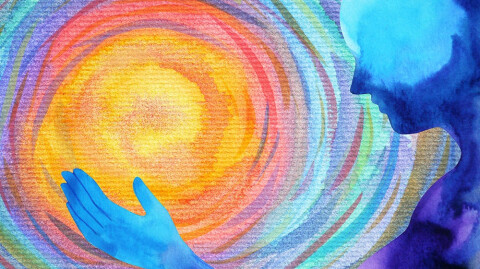Stress…we talk about it all the time. It seems to be the one thing no one looks for, but everyone finds. We know about the negative effects of stress, including: headaches, depression, heartburn, insomnia, weakened immune system, risk of heart attack, high blood pressure, high blood sugar, and more (Healthline, 2020). However, distress is not actually bad. It is the normal physical reaction to challenge, with a very important intention: seek safety, find relationship.
God created man to be different than the other animals. Genesis 1:26, after creating all of the animals of the earth, sky, and sea, God said, “Let US make man in OUR own image….” I emphasize the trinity illustrated in the words “us” and “our”. Being made in God’s image means we were made for more than just survival, we were made for relationship. As mentioned in Part 1, relationship is developed through the attachment cycle. There are two distinct stages of this cycle; distress and relief:
We can find this pattern woven quietly into all of creation. Consider the development of strong muscles. With the distress that is placed on the strands of tissue, they actually break or rupture the connection. In the period of rest and relief the muscle reconnects; stronger than before. How do you develop a flourishing plant? You prune it. The distress placed on the branches detaches them, allowing them to regrow healthier and fuller than before.
The same occurs for humans when our emotional or spiritual selves are distressed. In our distress we are designed to seek God. In His responsiveness, and relief, trust develops. These muscles of relationship create an increased tolerance for distress. Deepening our relationship with God and strengthening our internal resources for resiliency.
The cycle depends on both stages; distress and relief. Without the relief the muscles do not have the opportunity to reconnect and grow; instead they create an alternative strength formed through scar tissue. This type tissue is rigid and limited in motion. Similarly, when environmental distress is not met with relief and relationship, an alternative, often rigid and limiting, strength replaces the flexible and functional form.
If the cycle consists of mostly relief, without the distress, we experience atrophy. In the absence of exercise, the unused tissue deteriorates. Similarly, when environmental distress is limited, emotional and spiritual apathy replaces resiliency.
Going back to the distress of 2020; there have been some hard things! No doubt. For those who have suffered physically and financially, the distress has been more than many can bear. My intention is not to minimize those experiences. Or imply that the brokenness of those directly affected is rooted in weakness. I am speaking to those, like myself, who have not directly been harmed or irreversibly broken. I have primarily been affected by witnessing the trauma, being inconvenienced, experiencing frustration, and feeling fear in times that present obvious uncertainties. Is it possible that this distress FEELS harder on our generation because we haven’t been working the muscles our grandparents regularly exercised?
Consider the life experience of someone who is in their 90’s. Observe a person who has experienced: The Great Depression, World War II, The Korean War, Cuban Missile Crisis, President Kennedy Assassination, The Vietnam War, Civil Rights Movement, AIDS Epidemic, Dessert Storm(First Iraq War), 911, Afghanistan and Second Iraq War. Not to mention raising children in an era where one out of four children would not see their first birthday. Where untreated disease, disability, and death were as common as weddings and graduations. We can recognize the resiliency of this generation.
Perhaps it is fair to generalize that some of that perceived strength might also have been rigid and less emotionally connected. I am not saying that one is better than the other. But I am offering context to our perception of distress. Am I experiencing distress by having six children studying at home, or struggling with decisions that need to be made, discomfort of wearing a mask, fear for financial security, concern for the future of my country? Absolutely! Will this stress destroy me or my family? Absolutely not! Why, because I have a Father in Heaven who hears the cries of my distress. The sweat of exercise is expected. Tears in times of distress are essential. But I do not cry as those without a hope (1 Thessalonians 4:13-18). I cry like a beloved daughter, anticipating the response and the relief that comes by relationship with God through my Savior, Jesus Christ.
But we do not want you to be uniformed…that you may not grieve as those who have no hope.
1 Thess. 4:13
As someone who has been disabled since the age of 16, survived childhood sexual abuse, sat at the bedside of 3 children recovering from 8 open heart surgeries, juggled the challenges of raising 7 special needs children, chased a life flight plane 20 hours on ground while my son was being placed on life support, buried a child at the age of 6, come through divorce, struggled to makes ends meet, been in and out of the hospital, off and on oxygen, and facing the uncertainty of a potentially terminal disease… I don’t consider myself strong, but I am resilient.
My strength is in my relationship with God. My resiliency has developed through the repeated relief of His presence and provision. Without the distress I would still be His daughter, but I would not know the joy of trust, the hope of dependence, or the peace of belonging. I belong to my Father. He knows my name. He hears me when I cry. The discomfort of distress is real. I no longer try to deny that. In fact, I want to notice it. Because it is the segue to the relief. I don’t go looking for stress and I’m learning better not to create it for myself. But I do want to notice it. I don’t want to miss the signals that remind me to look for God and expect His response. When I notice distress, I seek relief. In the seeking, I always find Jesus. The Spirit helps me cry out to my Father, when I don’t have the words. My Heavenly Father is near. His faithful, loving-kindness, endures forever. Even through 2020.
For the LORD is good; his steadfast love endures forever, and his faithfulness to all generations.
Ps. 100:5




1 Comments
Elizabeth, that visual illustration about the distress and response cycle in the newborn is so simple yet profound. Wish you could explain that to our new moms. Thank you, Jerrie Amos